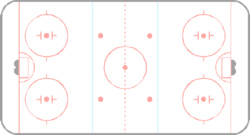
Why use numbers? Why even care?
Baseball is often looked at as the godfather of sports analytics. Bill James began publishing his Baseball Abstract on sabermetrics in 1977, which grew exponentially in popularity throughout the ‘80s. Billy Beane, General Manager of the Oakland A’s, actively and openly shaped team decisions based off of sabermetrics and the work of James. The A’s success was popularized through Michael Lewis’ book Moneyball and the movie starring Brad Pitt of the same name.
However, hockey has a long history of trying to measure the game in a more meaningful way. The traditional goal differential, commonly known as plus/minus, has a long history, extending to the Montreal Canadiens of the 1950s. Legend goes that early editions of Canada’s national team tracked shot attempts, while the Soviets were keenly interested in the differing impacts on how one enters the offensive zone.
The modern wave of hockey statistics has a very humble beginning though.
Over ten years ago a community of hockey fans tracked, studied, and wrote on different parts of the game on blogs read almost exclusively by each other. They yearned to learn more about the game and what drove team success.
One of the propelling factors was a strong dissatisfaction with the traditional plus/minus statistic.
Why was it that Zdeno Chara carried a heavily negative number for two years under the New York Islanders, which instantly flipped when moved to the Ottawa Senators? In his last season with the Senators, Chara produced 43 points, 212 shots, and carried a +17 rating. The very next season Chara played on the Boston Bruins, scored an identical 43 points, produced a similar level of 204 shots, but flipped to a stark -21 rating.
 In 2007, Tim Barnes, under the pseudonym Vic Ferrari and now of the Washington Capitals, was studying shot attempt differentials, which he designated as ‘Corsi’ after Buffalo Sabres’ goalie coach Jim Corsi. This statistic was eventually noted to predict a team’s future win percentage better than their goal differential, point totals, or win percentage. Further studies showed the statistic had a close relationship with scoring chances and could serve as proxy puck possession and zone time.
In 2007, Tim Barnes, under the pseudonym Vic Ferrari and now of the Washington Capitals, was studying shot attempt differentials, which he designated as ‘Corsi’ after Buffalo Sabres’ goalie coach Jim Corsi. This statistic was eventually noted to predict a team’s future win percentage better than their goal differential, point totals, or win percentage. Further studies showed the statistic had a close relationship with scoring chances and could serve as proxy puck possession and zone time.
Years later Eric Tulsky of the Carolina Hurricanes noted that players that drove shot differentials produced wins at a greater cost effectiveness than those that drove shooting percentages.
Statistics are simply measuring the events and results in the game and studying the relationship these statistics have with each other.
Analytics are simply using statistics to make more informed, and therefore potentially better, decisions.
We care about numbers because we care about the game.
How do certain players and teams drive wins? How do you identify these players and teams earlier and more accurately? How do different types of players differ in terms of cost effectiveness?
While the game is played on the ice, the objective is to pot more goals than your opponent on the score sheet.
– Garret Hohl 2015